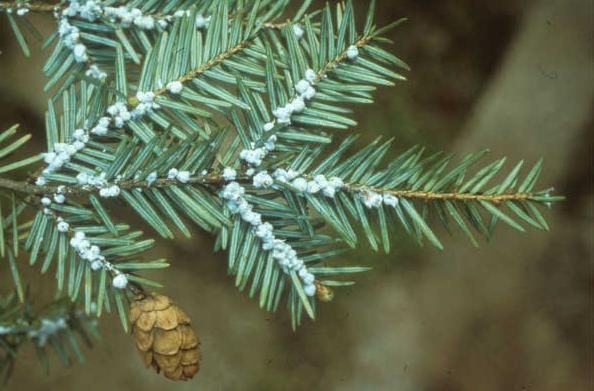Full-grown.
Undersides of flat needles are striped.
From the spindly trees folks grow around here, and the way they crowd them and torture them into HEDGES, for all love, you'd never know that the eastern hemlock(Tsuga canadensis) is a majestic member of late-stage successional forest here in New England.
I have been collecting locations of eastern
hemlocks (Tsuga canadensis) on my neighborhood perambulations over the last month or so, and have
a nice list of trees I look at regularly. I
was moved to do this less because of its iconic status--the third most
prevalent tree in Vermont--than because of the danger eastern hemlock faces. This tree is
endangered by yet another of our many alien invasives: the woolly adelgid.
Woolly adelgid (Adelges tsugae) was imported
accidentally from Japan, and was first noticed in the US near Richmond, VA in the 1920s. It is now affecting eastern hemlocks as far
north as Massachusetts. Woolly adelgid is
an aphid-like "true bug" (insect order Hemiptera) that sucks the sap and starch from hemlock
twigs, reducing their food stores. This weakens the tree, allowing other insect, disease and drought stresses to overwhelm it.
Wooly adelgid spreads short distances mainly by wind, and by birds and other animals the sticky egg sacks cling to. Transport of infected nursery trees can spread the insects more widely.
You will know you have this on your hemlock tree if you see the cottony egg masses on the undersides of twigs. Affected trees will gradually lose needles, becoming more "transparent" and turning grayish. Trees here in the north typically die four to ten years after infestation. If allowed to expand unchecked, the woolly adelgid could doom so many of these beautiful trees that whole forest ecosystems could be irrevocably altered.
Wooly adelgid spreads short distances mainly by wind, and by birds and other animals the sticky egg sacks cling to. Transport of infected nursery trees can spread the insects more widely.
Each cottony mass tyically hides an individual and its several hundred eggs.
You will know you have this on your hemlock tree if you see the cottony egg masses on the undersides of twigs. Affected trees will gradually lose needles, becoming more "transparent" and turning grayish. Trees here in the north typically die four to ten years after infestation. If allowed to expand unchecked, the woolly adelgid could doom so many of these beautiful trees that whole forest ecosystems could be irrevocably altered.
Property owners can spray their smaller
infested trees yearly with a non-toxic insecticidal soap or horticultural oil;
these smother the insects. Tree foliage
insecticides will keep on killing for several years, but are more toxic. Trees too large to spray can be treated with
soil drenches or other chemicals that are absorbed and transported throughout
the tree, but are not safe applied near bodies of water. For whole forests, several insect species that feed exclusively on wooly adelgid were deployed beginning in 2002 in hopes of bringing the pest population down to manageable levels over the long term.
A nice video pulls all this (and more) together here.
A nice video pulls all this (and more) together here.
There are a dozen or so stands of
eastern hemlock around my neighborhood, many consisting of several trees. (Probably thirty or more
trees of all sizes could be counted if including individuals in hedges.) Of these, three
stands have obvious signs of woolly adelgid.
There may well be more--I cannot closely examine trees in other people's yards. My own was a tiny individual transplanted to the woods behind our house; ten or so years later it is only waist-high, but free of insects. If landowners
keep an eye on their own trees and treat them if needed, I have hopes that the
spread of the insect can be slowed--at least locally.
What can you do? If you have any hemlocks, watch them. If you find woolly adelgid, consult with state agencies on what treatment would be best. If you see the insect on your neighbor's tree, let them know. Don't move an infected tree to a new location.










No comments:
Post a Comment